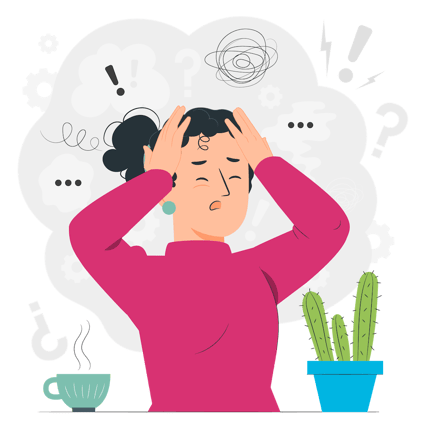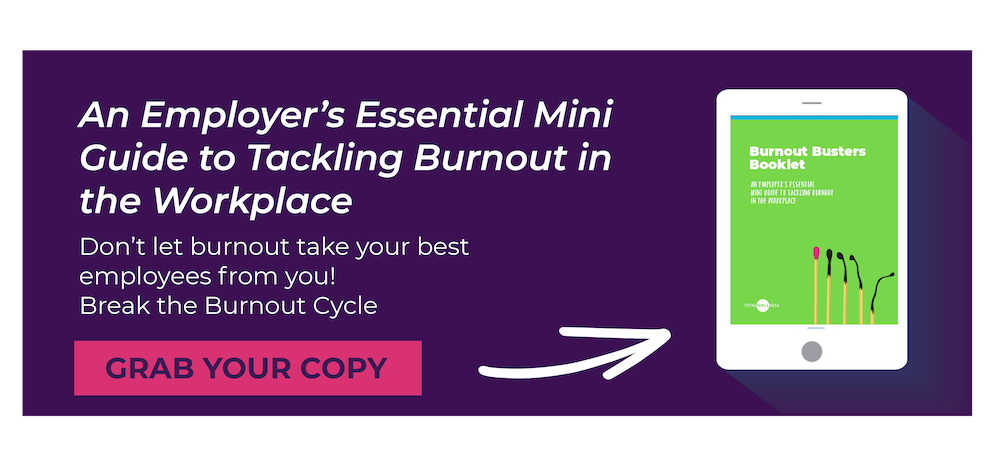 What triggers anxiety? The list of anxiety triggers can be a long one, unfortunately.
What triggers anxiety? The list of anxiety triggers can be a long one, unfortunately.
For those who suffer from anxiety, triggers may be different than those who deal with occasional anxiety. Either way, both experiences can feel overwhelming and stressful. In the workplace, a variety of factors can contribute to anxiety, creating an unhealthy work atmosphere for all.
The better employers understand what triggers anxiety, the more likely they can see why certain behaviors are exhibited by employees — like turning down office party invites or even promotions. Keeping in mind a list of anxiety triggers can help employers notice more quickly when someone may be having a hard time.
Anxiety has skyrocketed since the start of the pandemic. In fact, more than 40% of Americans reported mental distress increases due to the pandemic. As a result, more people are seeking mental health services like therapy.
Want to better understand the often overwhelming condition that is anxiety?
Here’s a list of anxiety triggers to take a look at and keep in mind.
What Triggers Anxiety?
As defined, anxiety is a chronic mental health condition that often causes excessive feelings of fear, worry, or tension. Individuals may experience panic attacks and even physical symptoms like nausea, chest pain, heart palpitations, sweating, and more.
It’s the most common mental illness in the United States with about 40 million individuals experiencing it annually.
Some individuals may suffer from generalized anxiety disorders or any number of anxiety-related conditions. These mental health conditions can be aggravated by numerous events, situations, interactions, etc.
The list of anxiety triggers may include:
Stress
At home or at work, stress is stress. If your employees aren’t great with stress management or relief, it can lead to anxiety or panic attacks. Discuss stress management in the workplace to help workers better let go and unwind.
Conflict
This is another one that whether it’s at home or at work or both, it can cause a lot of underlying and obvious anxiety. Sharing conflict policies in the workplace and even having a mediator on staff can help internally with work conflicts. Personal conflicts are a little more challenging, but offering those in-house resources can offer tools to employees to work on the at-home issues, too.
Caffeine
Caffeine may be good for waking the body up, but it also awakens the nervous system, too. Caffeine stimulates the fight or flight response, and it can even cause an anxiety attack. More than 400 milligrams at once can lead to feeling overstimulated and anxious. It can also cause nausea and a racing heart, further causing anxiety.
Medications
Certain medications are known to cause anxiety. This is known as a substance-induced anxiety disorder. It can cause nervousness, restlessness, or panic caused by taking or stopping a drug. Medicines with caffeine, those used for ADHD, and even asthma inhalers can cause anxiety.
Health Concerns
Getting upsetting news about health conditions can create a new wave of anxiety for many individuals. Whether it’s cancer or a chronic condition, the uncertainty of one’s health is often cause for anxiety. Proactive care and staying on top of appointments can make it easier to manage anxiety.
Social Gatherings
Social events can cause a lot of anxious feelings for those who don’t like being in groups or have introverted tendencies. Small-talk events aren’t fun for everyone, and it can often trigger anxiety for someone who might be self-conscious. Coping techniques are available for dealing with overwhelm at social events — like stepping out for fresh air, taking a bathroom break, or even using grounding exercises.
Medical Conditions
Sometimes, a medical condition that is untreated or new can spike anxiety. For example, adrenal gland conditions can increase anxious experiences. Likewise, health conditions like diabetes, gastrointestinal issues, or heart disease may cause anxiety symptoms to appear.
Workplace-specific triggers may include:
- Office gossip
- Tight deadlines
- Crowded workspaces
- Work-life balance difficulties
Additionally, certain life experiences — such as a traumatic event like a car accident — can trigger anxiety disorders for those who may already be prone to it. Anxiety disorders may also be inherited, according to Mayo Clinic.
Indicators An Employee May Be Struggling With Anxiety
For leaders who are in tune with their employees, it may be easy to spot when something is seriously amiss with a worker.
But, often, those with anxiety are high-performance employees and perfectionists, which makes the pressure even more difficult on them because they’ll often hide their anxiety. Co-workers and managers may not even realize someone is struggling with anxiety.
An employee with an anxiety disorder may experience or exhibit:
- Disengagement
- Poor performance
- Excessive missed worked days
- Physical symptoms and complaints like headaches, lack of sleep, stomach pains, etc.
High-stress environments are only one aspect that can contribute to anxiety. Giving presentations, office parties, and speaking up at weekly meetings can all cause anxiety or bring on anxiety attacks for those who may have an anxiety disorder.
Is Treatment Available?
Treatment is available and effective. Sometimes a combination of treatment options or even a single option can make all the difference in how anxiety impacts one’s life. Medication, therapy, transcranial magnetic stimulation, and alternative treatments (like yoga and acupuncture), are all available as treatment options.
Why Employers Should Care About Anxious Workers
Mental health isn’t a new health concern that’s just now showing up in workplaces due to the pandemic. For too long, many companies kept concerns like “mental breakdowns” hush-hush because talking about mental health was taboo.
Thankfully, that’s becoming less and less the case. In fact, the more company leadership understands mental health concerns and conditions, the better help they can get their staff, and, ultimately, the more healthy, productive, and well-off those workers will be.
Employers who better understand anxiety triggers can help workers struggling with the mental health condition feel safer and more at ease in the workplace. Plus, those companies investing and supporting mental health see an ROI of $4 for every dollar spent, according to research released in May 2021 from the National Safety Council and NORC at the University of Chicago.
By offering mental health support, companies can:
- Minimize absenteeism
- Decrease disability costs
- Reduce total medical costs
- Increase workplace productivity
Pre-COVID, that same research indicated organizations spent more than $15,000 a year for each individual employee experiencing mental health issues. That cost has likely gone up as the need for more mental health care has increased during the pandemic.
Like most health-related concerns, if mental health is taken care of early on — think of issues avoided by incorporating a good diet and regular exercise — it can reduce the chance of a mental health crisis.
Prioritizing both mental and physical well-being in the workplace can make all the difference for employee experience as well as company productivity, morale, function, and more.
Anxiety-Reducing Tips to Share With Employees
For people who don’t have anxiety, it may seem like others with it are overreacting, blowing situations out of proportion, being dramatic, and more. But for the person experiencing anxiety, it feels real and is their reality at that moment. Offering compassion and empathy for someone experiencing extreme anxiety can be helpful for them to get through the anxious moment they’re going through.
Here are a few anxiety-reducing tips to share with your team
- Take a minute - Sometimes, workers just need a minute to process information or to calm down. Getting worked up and stressed out takes its toll on the mind and body. Mindful breathing or just taking a quiet walk alone is sometimes enough to reset.
- Get organized - Clutter never helped anyone get tasks done. It also doesn’t help someone with anxiety who already has a mind full of tasks, to-dos, and worries. Ask your employees to take time at the end of each day to organize and declutter workspaces for a more effective, calm, peaceful work environment for themselves.
- Talk with trusted colleagues - Even if team members don’t speak directly to leadership, encourage workers to find someone they can confide in at the workplace. Let them know that leadership supports letting off steam about the company and work as long as it isn’t toxic gossip.
- Practice time management - Encourage to-do lists and prioritization to keep overwhelm at a minimum. Offer your team collaboration tools, resources, and even time management workshops to help them learn how to better use their precious time wisely. Time management is an excellent skill not just for the workplace, but also to use in life, in general, to keep processes and experiences flowing.
- Set boundaries - This can be particularly hard for anxiety-ridden individuals as they may think someone will think less of them if they say no. But, sometimes it’s essential to say no to extra work, overtime, taking on work duties of a colleague too often, etc. Ask employees to practice boundary setting by not taking work home with them, checking email after-hours, and the like.
- Encourage days off - If you see an employee really struggling, sometimes a break is all they really need. Let them take those days off that they’ve saved up — or better yet, give them use-as-needed mental health days — to help them regroup and unwind. Sometimes, a break from all the overwhelm is all that’s needed.
Related: 23 Expert Anxiety Management Techniques to Help Your Employees
Lastly, while you can offer all these tips, advice, resources, and more, some individuals still won’t want or seek help. As the saying goes, “You can lead a horse to water, but you can’t force it to drink it.” Some employees may be anxious and miserable and don’t have any intention to change. Others may welcome suggestions. Taking time to discuss mental health issues, resources, and providing mental health awareness can make all the difference — even if it’s just for one employee.
Looking for ways to keep your team healthy in 2022? Check out our free resource: 95 Low-Cost Ideas for Workplace Wellness for tons of ideas!



